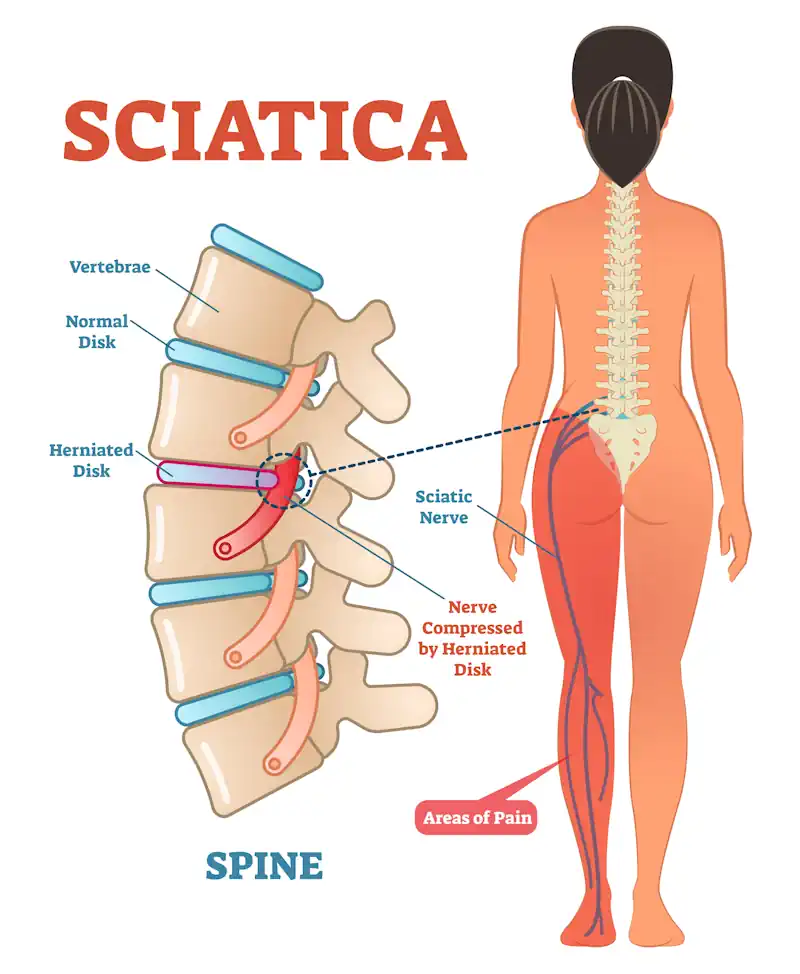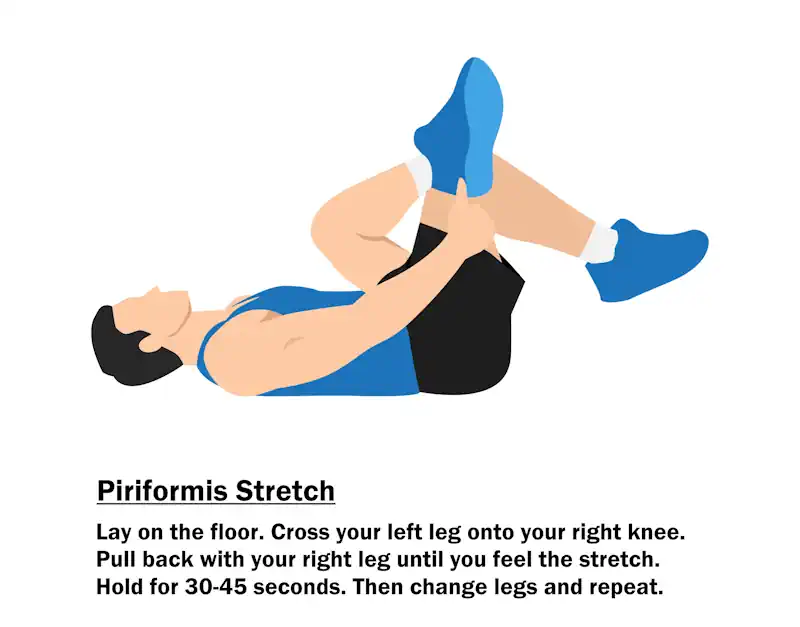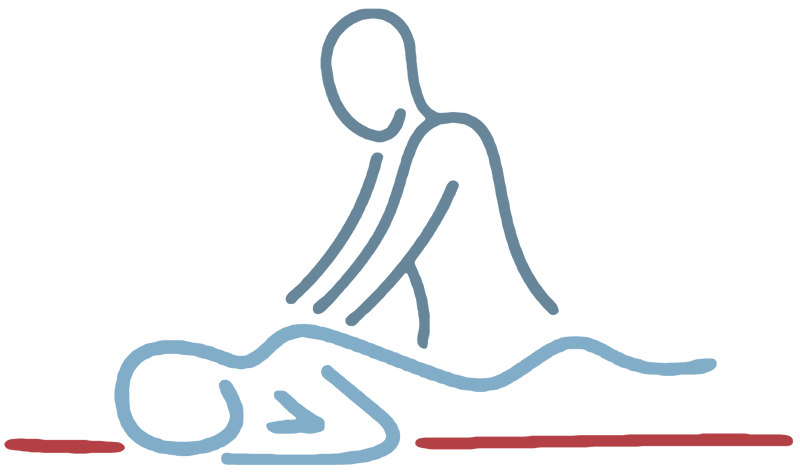Highlands Ranch Therapeutic Massage
- (720) 235-8692
- fbingemer@hrtherapeuticmassage.com
- 9am to 8pm M-F
Sciatica Relief in Highlands Ranch: How Massage Therapy Can Help Ease the Pain

As a Massage Therapist since 2012, I have seen many patients with sciatic nerve pain and have helped them find sciatica relief through different massage techniques. Pain in any part of the body can be bothersome. But no pain is quite like sciatic nerve pain. Sciatic nerve pain can range from numbness and tingling to electrical shocks when a patient moves even the slightest. And, it can leave patients with the inability to move at all due to excruciating pain.
The thing about sciatica is that it can come on without any warning. One minute you are fine. The next minute, pain. I have seen patients dealing with flare-ups from overexertion. Others have been living with sciatica for months or even years, unsure where to turn next. Many have tried medications, stretches, or even injections with limited relief. Massage offers a natural, hands-on way to feel better.
At Highlands Ranch Therapeutic Massage, our goal is to understand what’s behind the pain—not just where it hurts, but why. Every session is customized to target the muscle tension, inflammation, or nerve compression that’s triggering your symptoms. Sciatica doesn’t have to control your life. With the right care, it’s absolutely possible to move freely, sleep better, and feel like yourself again.
 What Is Sciatica and Why Does It Hurt So Much?
What Is Sciatica and Why Does It Hurt So Much?
Sciatica is a condition caused by irritation or compression of the sciatic nerve. This nerve is the longest in your body, running from your lower back down through your hips and buttocks into each leg. When it becomes inflamed or pinched, it causes pain that can radiate from your lower back all the way to your foot.
Herniated discs, spinal stenosis, degenerative disc disease, and even tight muscles like the piriformis can all contribute to this painful condition. Some people experience numbness or tingling. Others report a constant throbbing in one leg or difficulty walking and sleeping.
According to the Cleveland Clinic, as many as 40% of people will experience sciatica during their lifetime. It’s not just uncomfortable, it can be life-altering. But massage therapy offers a natural path forward.
How Massage Therapy Targets the Root of Sciatica
Massage doesn’t just mask the pain. It addresses the underlying causes.
Massage therapy helps reduce inflammation and muscular tension. When the muscles surrounding the sciatic nerve, like the glutes and hamstrings, are tight, they can put pressure on the nerve. By loosening those muscles, we can relieve that pressure and allow the nerve to calm down.
Another benefit is improved blood circulation. When blood flows freely, oxygen and nutrients reach the inflamed area, speeding up recovery. Massage also triggers the release of endorphins, which are the body's natural painkillers.
Our clients often report that even one session brings noticeable relief. But long-term improvement comes from consistent care and understanding which techniques work best for you.
The Most Effective Massage Techniques for Sciatica Relief
The most effective massage techniques for sciatica relief are different for each person. Different types of massage offer different benefits. As we work with patients we want to determine the root cause of the sciatic pain. Depending on the cause, we may use:
Deep Tissue Massage
This technique uses slow, firm pressure to reach deeper layers of muscle and fascia. It breaks up adhesions, releases chronic tension, and improves mobility. For sciatica caused by muscle compression, deep tissue massage can be a game changer.
Trigger Point Therapy
Trigger points are small, tight knots that form in muscle tissue and can refer pain to other areas. In the case of sciatica, a trigger point in your glute might send pain all the way down your leg. By locating and releasing these points, we can significantly reduce referred pain.
Myofascial Release
The fascia is the connective tissue that surrounds your muscles. When it becomes tight or stuck, it restricts movement and adds to discomfort. Myofascial release uses sustained pressure to stretch and soften this tissue, giving your body room to move and breathe.
Prenatal Massage
Pregnant clients often suffer from sciatica due to the baby’s position and weight pressing on the sciatic nerve. Prenatal massage at Highlands Ranch Therapeutic Massage is carefully designed to offer relief without compromising safety.
Using the right combination of these massage methods can significantly reduce your pain and improve your mobility. We customize every session to meet your unique needs for that day.
What Happens During a Sciatica Massage Session?
If you’re new to massage therapy, you might wonder what to expect. The process begins with a brief consultation. Your therapist will ask questions about your symptoms, medical history, and activity level. This information helps shape a targeted treatment plan.
The session will typically focus on your lower back, glutes, hips, hamstrings, and calves. These are the areas most likely to contribute to sciatic nerve compression. We will use a mix of techniques, always checking in to ensure the pressure feels right.
After your massage, you’ll likely feel more relaxed and mobile. Some soreness is normal, especially after deep tissue work. Drinking water, doing light stretching, and avoiding strenuous activity for the next 24 hours can help your body adjust and heal.
How Often Should You Get Massage for Sciatica?
The frequency of massage depends on the severity and cause of your sciatica. In the early stages of a flare-up, weekly or twice-weekly sessions may provide the best results. As your condition improves, you can shift to a maintenance schedule.
Most clients benefit from massages every two to four weeks to keep tension from returning. Consistency is key. Think of it as ongoing care, like exercise or nutrition. You wouldn’t expect one gym visit to change your life and the same goes for massage.
If you’re working with a chiropractor, physical therapist, or doctor, let us know. Combining therapies can enhance results, but coordination matters.
 Simple Ways to Manage Sciatica Between Appointments
Simple Ways to Manage Sciatica Between Appointments
Massage is powerful, but your daily habits also play a role in pain management. Between sessions, there are things you can do at home to support your healing.
Gentle Stretching
Tight hips and hamstrings often worsen sciatic symptoms. Gentle stretches like the piriformis stretch, hamstring stretch, and child's pose can ease tension and improve flexibility.
Heat and Ice Therapy
Apply a cold pack to reduce inflammation during a flare-up. Later, switch to heat to relax tight muscles. A warm bath with Epsom salts can be particularly soothing.
Stay Active, But Don’t Overdo It
Too much sitting can aggravate sciatica. Light walking or yoga can help, but avoid activities that jar your spine or overstrain your muscles.
Ergonomics Matter
Adjust your chair, desk, and car seat to support proper posture. Avoid crossing your legs. Small changes make a big difference when it comes to nerve health.
Why Local Clients Choose Highlands Ranch Therapeutic Massage
There are many massage clinics out there—but few offer the focused care and experience you’ll find here.
At Highlands Ranch Therapeutic Massage, our therapists understand how sciatica impacts your daily life. They listen. They customize every session. And they don’t just chase symptoms. They help you feel better, move better, and live better.
We offer a calm, professional environment where healing begins the moment you walk in the door. Whether you’re dealing with acute flare-ups or long-term nerve pain, we’re here to support your recovery.
Clients appreciate our flexible scheduling, straightforward communication, and commitment to results. We believe you deserve real relief—not just temporary distraction.
Don’t Wait to Find Relief—Book Your Massage Today
Living with sciatic pain doesn’t have to be your new normal. Massage therapy offers a safe, natural, and effective solution that supports your body’s own ability to heal.
Our skilled therapists are ready to help you identify the source of your discomfort and create a plan for long-term relief. With consistent care, many of our clients experience fewer flare-ups, improved mobility, and a dramatic drop in pain.
If you’re ready to take the first step toward comfort and freedom of movement, we invite you to schedule your appointment today.
Your relief is closer than you think. Let Highlands Ranch Therapeutic Massage help you get there.
